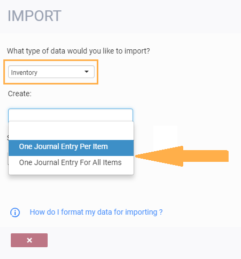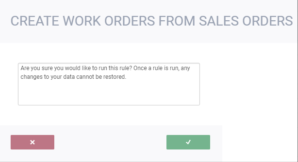What's new with Paragon - February 5, 2019
New features and bug fixes every two weeks. Come back here to check out what's new.
Filter the data in your list views with a toggle feature
Paragon has always offered the ability to show or hide certain records in the list view screens (inactive for references and voided status transactions). We have improved this feature by eliminating the right-click functionality and replacing it with a toggle button. Now you can decide what you want to see in any list view screen and Paragon will remember your settings by user and by list view screen.

Prevent automated journal entries without exchange rates
Whenever financial transactions are issued, Paragon can be set to generate automatic journal entries for those transactions. If there is no exchange rate established for this transaction scenario (date range and currency), Paragon will prevent the transaction from being issued and advise you as to why you cannot proceed.

Import inventory and generate one or many journal entries
Let's say you take advantage of the universal translator to easily import your inventory units whenever you do a stock count. Paragon has a great feature that allows you to decide if you want to create automatic journal entries for all inventory adjustments. With that being said, if you have a thousand lines of inventory adjustments from the UT file, you would end up with a thousand journal entries - impossible to manage. We have now given you the ability to decide if you require one entry for each item or one global entry for the entire import. This prevents having excessive numbers of records in your GL that you just don't need.

A/R aging report by date
An aging report is a crucial tool for running your business. It lets you see how much is owed to you by each customer as of the present moment. Going forward, you will now also be able to see how much was owed to you as of any given date in the past. Using the due date (or the transaction date if the due date is not completed) on any financial transaction, Paragon can tell you what was owed to you at that time.

Rule: Automated work orders generated from sales orders
When requesting units from a factory or contractor, it's very helpful to be able to group all of your requests into one transaction. This may be useful for obtaining bulk pricing or to help plan your production. We have developed a 'run now rule' that generates work orders from your issued sales order lines. The work orders are generated based on the preferred contractor for each product, and they can be automatically grouped by any attribute of your choice.

Rule: Split automatic receipts by vendor shipping address
So, we've shown you a few work flow rules over the last couple of updates. We developed a rule to automatically create purchase orders from your sales orders - great. We also recently devised a rule to automatically create receipts from any shipments generated from those sales orders - fantastic. This should already be making fast work of those large long-term customer projects. Well, we've now developed the piece de resistance. We've tweaked that last rule to split the automatically generated receipts based on the pick-up addresses of your vendors. This means that if your supplier has multiple warehouses or locations, you can determine which location the auto-receipts should be made for. No need to manually manipulate the receipts after creation.

Need help setting up rules? Contact us at support@paragon-erp.com. It'll be our pleasure to assist you.
Bugs
Here's a list of bugs we've eliminated with this update:
- Various improvements to the address modals
- Several fixes for emails sent from the action button in transactions
- Adjustments to the notes section in reference modules
- Corrections to user access for custom attributes
- Improvements to the material pick creation process
- Adjustments to overall functionality of financial transaction lines
- Implementation of European standard formatting for number attributes
- Improved logic for differences between free flow number and free flow text attributes
- Adjusted logic for the universal translator when importing references
![paragon logo-1.png]](https://support.paragon-erp.com/hs-fs/hubfs/paragon%20logo-1.png?height=50&name=paragon%20logo-1.png)